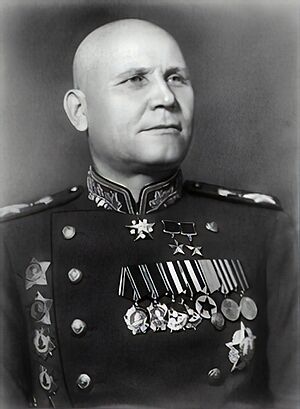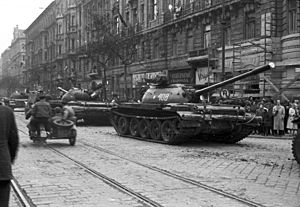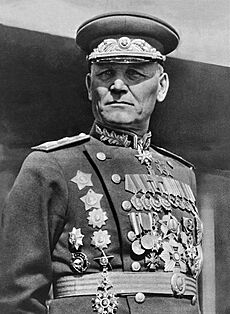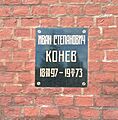Ivan Konev facts for kids
Quick facts for kids
Marshal of the Soviet Union
Ivan Konev
|
|
|---|---|

Konev in 1945
|
|
| 1st Supreme Commander of the Unified Armed Forces of the Warsaw Treaty Organization | |
| In office 14 May 1955 – April 1960 |
|
| Preceded by | Position created |
| Succeeded by | Andrei Grechko |
| 1st High Commissioner of the Soviet occupation of Austria | |
| In office July 1945 – 25 April 1946 |
|
| President | Karl Renner |
| Chancellor | Karl Renner |
| Preceded by | Fyodor Tolbukhin (as military commander) |
| Succeeded by | Vladimir Kurasov |
| Personal details | |
| Born | 28 December 1897 Lodeyno, Nikolsky Uyezd, Vologda Governorate, Russian Empire |
| Died | 21 May 1973 (aged 75) Moscow, Russian SFSR, Soviet Union |
| Resting place | Kremlin Wall Necropolis |
| Awards | Hero of the Soviet Union (twice) |
| Military service | |
| Allegiance | |
| Branch/service | |
| Years of service | 1916–1962 |
| Rank | Marshal of the Soviet Union (1944–1962) |
| Commands | 2nd Rifle Division 2nd Red Banner Army Transbaikal Military District Steppe Front Kalinin Front Western Front 2nd Ukrainian Front 1st Ukrainian Front Commander of Warsaw Pact Armed Forces |
| Battles/wars |
|
Ivan Stepanovich Konev (Russian: Ива́н Степа́нович Ко́нев; 28 December 1897 – 21 May 1973) was an important Soviet general and Marshal of the Soviet Union. He led Red Army forces on the Eastern Front during World War II. His armies were responsible for taking back many areas of Eastern Europe that were controlled by the Axis Powers.
Konev was born into a farming family. He joined the Imperial Russian Army in 1916 and fought in World War I. In 1919, he became a member of the Bolsheviks and served in the Red Army during the Russian Civil War. After finishing his studies at the Frunze Military Academy in 1926, Konev moved up in the Soviet military ranks. By 1939, he was a candidate for the Central Committee of the Communist Party.
After Nazi Germany invaded the Soviet Union in 1941, Konev took part in major battles. These included the battles of Moscow and Rzhev. He also commanded forces in big Soviet attacks like the Battle of Kursk, the Dnieper–Carpathian Offensive, and the Vistula–Oder Offensive. In February 1944, he was made a Marshal of the Soviet Union. Towards the end of the war, Konev's 1st Ukrainian Front competed with Georgy Zhukov's armies in the Race to Berlin. Konev was the first Allied commander to enter Prague, the capital of Czechoslovakia, after the Prague uprising.
After the war, he replaced Zhukov as the commander of Soviet ground forces in 1946. In 1956, he became the commander of the Warsaw Pact armed forces. He played a role in the Soviet response to the Hungarian Revolution. In 1961, as commander of Soviet forces in East Germany, he ordered the closing of West Berlin to East Berlin when the Berlin Wall was being built. Konev remained a respected military figure in the Soviet Union until he passed away in 1973.
Contents
Early Life and Beginnings
Ivan Konev was born on December 28, 1897. His hometown was the village of Lodeyno in the Vologda Governorate, which was part of the Russian Empire. His family were farmers of Russian background.
Konev went to a local school in 1906 and then another school in 1912. When he was 15, he started working as a forester and lumberjack. He worked in places like Podosinovets and Arkhangelsk.
Military Career Journey
In early 1915, Konev was called to join the Imperial Russian Army. He was sent to Moscow for artillery training and became a junior sergeant. In July 1917, he fought in World War I during the Kerensky Offensive in Galicia.
After the October Revolution in November 1917, he went home. In 1918, he joined the Russian Communist Party (Bolsheviks) and the Red Army. He served as an artilleryman during the Russian Civil War (1917-1923) in the Russian Far Eastern Republic. One of his commanders was Kliment Voroshilov, who was a close friend of Joseph Stalin. This connection helped Konev's career later on. He also helped put down the 1921 Kronstadt rebellion.
In 1926, Konev finished advanced training at the Frunze Military Academy. From then until 1941, he took on more important commands. He became the head of the Transbaikal and then the North Caucasus Military Districts. In 1934, he became a commander and political leader of the 37th Rifle Division. By July 1938, he was in charge of the 2nd Red Banner Army. In 1937, he became a representative in the Supreme Soviet, and in 1939, he joined the Party Central Committee.
World War II Campaigns
When Nazi Germany launched Operation Barbarossa and invaded the Soviet Union in June 1941, Konev was given command of the 19th Army. His army fought defensive battles as the Red Army retreated towards Smolensk and then closer to Moscow.
From October 1941 to August 1942, he commanded the Kalinin Front. He played a key role in the battles around Moscow and the Soviet counter-attack in the winter of 1941–42. Because of his success in defending Moscow, Stalin promoted Konev to Colonel-General. In the summer of 1942, Konev led the Kalinin Front and later the Western Front in the battle of the Rzhev salient.
Konev commanded different "Fronts" (large army groups) for the rest of the war. He led the Soviet Western Front until February 1943, the North-Western Front from February to July 1943, and the 2nd Ukrainian Front from July 1943. Later, he commanded the 1st Ukrainian Front until May 1945.

He took part in the Battle of Kursk, leading the southern part of the Soviet counter-attack, known as the Steppe Front. Here, he actively used maskirovka, which means using military camouflage and deception to trick the enemy. For example, he camouflaged defense lines and supply areas. He also created fake units and supply points and a fake air-defense system. He even used scouting teams to check how good his army's camouflage was. This helped his forces surprise the Germans.
Because of these tricks, the Germans greatly underestimated the strength of the Soviet defenses. A German general, General G. Schmidt, later wrote that they did not expect even a quarter of the Russian strength they faced.
After the Soviet victory at Kursk in August 1943, Konev's armies recaptured cities like Belgorod, Odessa, Kharkiv, and Kyiv. The Korsun–Shevchenkovsky Offensive led to the Battle of the Korsun–Cherkassy Pocket from January 24 to February 16, 1944. In this battle, Konev's 2nd Ukrainian Front and Nikolai Vatutin's 1st Ukrainian Front trapped German forces west of the Dnieper river. After weeks of fighting, the Soviet armies destroyed the trapped German forces.
For his success in Ukraine, Konev was promoted to Marshal of the Soviet Union in February 1944. He was one of Stalin's favorite generals.
Throughout 1944, Konev's armies moved from Ukraine and Belarus into Poland and then into Czechoslovakia. In May 1944, he took part in an unsuccessful invasion of the Balkans.
By July, he had reached the Vistula River in central Poland and was awarded the title of Hero of the Soviet Union. In September 1944, his forces, now called the 4th Ukrainian Front, moved into Slovakia. They fought alongside the Slovak partisans who were rebelling against German occupation.
In January 1945, Konev, along with Georgy Zhukov, led the Soviet armies in a huge winter attack in western Poland. They pushed the German forces from the Vistula to the Oder River. In southern Poland, his armies captured Kraków on January 18, 1945. Soviet historians say that Konev saved Kraków from being destroyed by the Nazis by ordering a quick attack on the city. Konev's January 1945 attack also stopped the Germans from destroying the Silesian industries as they retreated.
In April, Konev's troops, along with the 1st Belorussian Front led by Marshal Zhukov, crossed the Oder River and moved towards Berlin. Konev's forces entered the city first, but Stalin gave Zhukov the honor of capturing Berlin and raising the Soviet flag over the Reichstag. Konev was ordered to move southwest. His forces met parts of the United States Army at Torgau on April 25, 1945. They also recaptured Prague on May 9, 1945, shortly after the German forces officially surrendered.
After the War
After the war, Konev was made the head of the Soviet occupation forces in Eastern Germany. He was also the Allied High Commissioner for Austria. In 1946, he became the Commander-in-Chief of the Soviet Ground Forces and First Deputy Minister of Defense of the Soviet Union, taking over from Zhukov. He held these jobs until 1950, when he became commander of the Carpathian Military District. He stayed in this role until 1960, when he retired from active service. However, in 1961–62, he was called back to duty. He was again commander of the Soviet forces in East Germany. During this time, he ordered the closing of West Berlin to East Berlin during the building of the Berlin Wall. After this, he was given the mostly ceremonial job of Inspector-General of the Defense Ministry.
After Stalin's death, Konev became more important again. He was a key supporter of the new leader, Nikita Khrushchev. He was put in charge of the trial of the Stalinist police chief Lavrenty Beria in 1953. He was again appointed First Deputy Minister of Defense and commander of Soviet ground forces. He held these posts until 1956, when he was named Commander-in-Chief of the Armed Forces of the Warsaw Pact. Soon after this, he led the Soviet forces during the Hungarian Revolution. It has been said that Konev visited military units in Czechoslovakia in May 1968 to gather information, but there is no official proof of this.

Konev remained one of the Soviet Union's most respected military figures until he died in 1973. He was married twice. His daughter, Nataliya, is a dean at the Military University of the Ministry of Defense of the Russian Federation.
In 1969, the Ministry of Defence of the USSR published Konev's war memoir, called Forty-Five. It was later translated into English that same year and published as I. Konev – Year of Victory.
Konev passed away on May 21, 1973, in Moscow at the age of 75. His ashes were placed in the Kremlin Wall Necropolis, where many important figures of the USSR are buried. You can still visit it today.
Monuments and Legacy
Konev has monuments, mostly in Russia. These can be found in places like Svidník, Patriot Park (near Moscow), Kirov, Belgorod, Nizhny Novgorod, Omsk, and Vologda.
On January 9, 1991, a sculpture of him in Kraków, Poland, was taken down. It had only been there for less than four years. The sculpture was then given to the Russian city of Kirov. A memorial plaque is still on the brick wall in front of the apartment building where he used to live in Moscow, which is close to the Kremlin.
The Konev monument in Prague 6, Czech Republic, was put up by the communist government of Czechoslovakia in 1980. This monument became a topic of debate in 2018. The city then added text to the monument, explaining that Konev was involved in the suppression of the Hungarian Revolution. The monument was removed on April 3, 2020. The Czech president, Miloš Zeman, criticized this removal. Soon after, the Investigative Committee of the Russian Federation announced they would start an investigation into the "defiling of symbols of Russia's military glory."
Images for kids
-
Konev's grave in the Kremlin Wall
-
Former monument in Kharkiv
-
Bust in Slovakia
Honours and Awards
- Soviet Union
| "Gold Star" Hero of the Soviet Union, twice (July 29, 1944, June 1, 1945) |
| Order of Victory (No. 5 – March 3, 1945) |
| Seven Orders of Lenin (July 29, 1944, February 21, 1945, December 27, 1947, December 18, 1956, December 27, 1957, December 27, 1967, December 28, 1972) |
| Order of the October Revolution (February 22, 1968) |
| Order of the Red Banner, three times (February 22, 1938, November 3, 1944, June 20, 1949) |
| Order of Suvorov, 1st class, twice (August 27, 1943, May 17, 1944) |
| Order of Kutuzov, 1st class, twice (April 9, 1943, July 28, 1943) |
| Order of the Red Star, (August 16, 1936) |
| Medal "For the Defence of Moscow" (May 1, 1944) |
| Medal "For the Liberation of Prague" (June 9, 1945) |
| Medal "For the Capture of Berlin" (June 9, 1945) |
| Medal "For the Victory over Germany in the Great Patriotic War 1941–1945" (1945) |
| Jubilee Medal "Twenty Years of Victory in the Great Patriotic War 1941-1945" (1965) |
| Jubilee Medal "XX Years of the Workers' and Peasants' Red Army" (February 22, 1938) |
| Jubilee Medal "30 Years of the Soviet Army and Navy" (February 22, 1948) |
| Jubilee Medal "40 Years of the Armed Forces of the USSR" (February 17, 1958) |
| Jubilee Medal "50 Years of the Armed Forces of the USSR" (1968) |
| Jubilee Medal "In Commemoration of the 100th Anniversary of the Birth of Vladimir Ilyich Lenin" (1969) |
| Honorary weapon – sword inscribed with golden national emblem of the Soviet Union (February 22, 1968) |
- Honorary citizen of Bălți (Moldova) and other cities
- Foreign
| Hero of the Czechoslovak Socialist Republic (April 28, 1970) |
| Hero of the Mongolian People's Republic (Mongolian People's Republic, May 7, 1971) |
| Patriotic Order of Merit, in silver (East Germany) |
| Order of Sukhbaatar, twice (Mongolian People's Republic, 1961 and 1971) |
| Order of the Red Banner (Mongolian People's Republic) |
| Virtuti Militari, 1st class (Poland) |
| Cross of Grunwald, 1st class (Poland) |
| Order of Polonia Restituta, 1st class (Poland) |
| Golden Order of the Partisan Star (Yugoslavia) |
| Order of the People's Republic of Bulgaria, 1st class (Bulgaria) |
| Order of Klement Gottwald (Czechoslovakia) |
| Order of the White Lion, 1st class (Czechoslovakia) |
| Military Order of the White Lion, 1st class (Czechoslovakia) |
| War Cross 1939–1945 (Czechoslovakia) |
| Order of Merit of the Hungarian People Republic (Hungary) |
| Order of the Hungarian Freedom (Hungary) |
| Honorary Knight Commander, Order of the Bath (UK) |
| Military Cross (UK) |
| Grand Officer of the Legion of Honour (France) |
| Croix de guerre 1939–1945 (France) |
| Chief Commander of the Legion of Merit (USA) |
| Medal of Sino-Soviet Friendship (China) |
See also
 In Spanish: Iván Kónev para niños
In Spanish: Iván Kónev para niños










